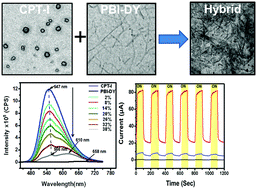Modulation of the optoelectronic properties of a donor–acceptor conjugate between a cationic polythiophene and a peptide appended perylene bisimide ampiphile†
Abstract
A peptide conjugated perylene bisimide based amphiphile (PBI-DY) undergoes soluble fibrillar network self-assembly in phosphate buffer and this peptide acceptor interacts well with a polythiophene based cationic polymer (CPT-I), as evident from optical, electrical and morphological investigations. UV-vis spectra exhibit a gradual red shift of the π–π* transition peak of CPT-I from 428 to 455 nm and the PL intensity of CPT-I becomes gradually quenched on addition of PBI-DY with a maximum at 32 wt% concentration. High-resolution transmission electron microscopy studies indicate the presence of a nano-fibrillar morphology of PBI-DY and a core–shell morphology of the cationic polythiophene, whereas the hybrid has a new fibrillar network morphology with some aggregated polythiophene of smaller size (black spots). The dc-conductivity values are 0.44, 0.23 and 2.71 μS cm−1 for CPT-I, PBI-DY and the hybrid (1 : 1, w/w), respectively, and this is almost in accordance with the optical band gap values measured using the Tauc plot. The current–voltage (I–V) plot indicates a semiconducting nature whereas the hybrid exhibits a better semiconducting property arising from both electronic and ionic contributions to the current flow. Interestingly PBI-DY shows a photo switching property with an on–off gain of 1.7 and the polymer also exhibits photo switching behaviour with a gain of 1.6 using monochromatic light, however the hybrid shows an enormous enhancement of the photo switching property compared to the individual components with a photocurrent gain of 4.1 due to the good interaction between donor CPT-I and acceptor PBI-DY. An attempt has been made to explain the results via non-destructive characterization using impedance spectroscopy and the charge transfer resistances are found to be in accordance with the optical band gap data. Additionally, the CPT-I–PBI-DY hybrid exhibits Warburg impedance, not present in the components, due to the relatively free iodide ions in the conjugate. Thus modulation of the optoelectronic and photo switching properties is observed due to the formation of a donor–acceptor conjugate between CPT-I and PBI-DY.



 Please wait while we load your content...
Please wait while we load your content...